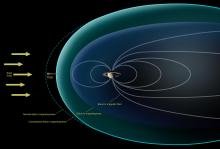Listen to today's episode of StarDate on the web the same day it airs in high-quality streaming audio without any extra ads or announcements. Choose a $8 one-month pass, or listen every day for a year for just $30.
You are here
Moon and Saturn
Earth is loosening its grip on the Moon. As a result, the Moon moves about an inch and a half farther from us every year. And the same thing is happening to the biggest moon of Saturn — but at a faster rate.
As the Moon orbits Earth, its gravitational pull on our planet creates the tides. The sloshing of the tides causes Earth to lose energy, so it spins a tiny bit slower. To keep the books in balance, the Moon gains the energy that Earth loses. That causes the Moon to move away from us.
The same process is creating a change in the orbit of Titan, one of the most intriguing worlds in the solar system. Titan is about half again as big as the Moon, and it’s blanketed by a cold, thick atmosphere. Liquid methane and ethane fill lakes and seas and carve riverbeds.
Titan’s gravity squeezes the interior of Saturn. That appears to cause Saturn to “wiggle” a bit. Saturn loses energy through the wiggle. The lost energy is transferred to Titan, making it move outward. In fact, observations by the Cassini spacecraft show that Titan is moving away from Saturn by about four inches per year. That means the big moon must have formed much closer to Saturn, and has spent the last four-and-a-half billion years gradually sneaking away.
Look for Saturn quite close to our moon this evening. It looks like a bright star, and is just above the Moon at nightfall. The brighter planet Jupiter is off to the right.
Script by Damond Benningfield






